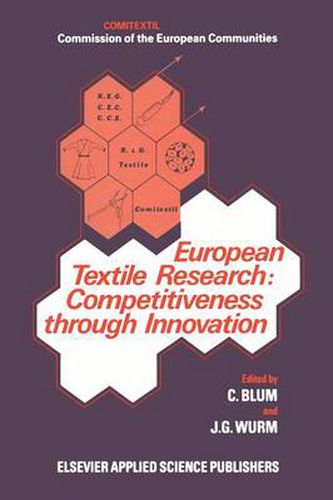Readings Newsletter
Become a Readings Member to make your shopping experience even easier.
Sign in or sign up for free!
You’re not far away from qualifying for FREE standard shipping within Australia
You’ve qualified for FREE standard shipping within Australia
The cart is loading…






This title is printed to order. This book may have been self-published. If so, we cannot guarantee the quality of the content. In the main most books will have gone through the editing process however some may not. We therefore suggest that you be aware of this before ordering this book. If in doubt check either the author or publisher’s details as we are unable to accept any returns unless they are faulty. Please contact us if you have any questions.
J. IIONEYMAN The second textile and clothing research and development programme (1982-1985) supported by the EEC was undertaken with the prime objective of strengthening the competitiveness of the Community textile industries by stimulating innovation. From the generation of the research ideas through to the application of new technologies, the optimum conditions for scientific research demand highly trained and qualified people working in well-equipped laboratories. The Commission, in collaboration with the textile industries working through Comitextil, participated in the selection of suitable topics and supported the implementation of the programme and the publication and dissemination of the results. In all, 24 institutes in seven member countries carried out the programme which was divided into 35 separate but co-ordinated contracts. The costs were shared equally between the Commission and the participat ing institutes. The results were presented by selected specialists at the closing symposium held in Luxembourg on the 18 and 19 September 1985. The technical sessions covered the four topics : garment physiology and construction, quality of knitted fabrics and articles, application of new spinning technologies in the wool industry, and the upgrading of linen. In addition, prominent industrialists and Commission officials presented papers concerned with the present situation and the prospects for textile manufacture in the Community. Possible future research topics were outlined and the need was stressed for an increase in the amount of research and development to be carried out.
$9.00 standard shipping within Australia
FREE standard shipping within Australia for orders over $100.00
Express & International shipping calculated at checkout
Stock availability can be subject to change without notice. We recommend calling the shop or contacting our online team to check availability of low stock items. Please see our Shopping Online page for more details.
This title is printed to order. This book may have been self-published. If so, we cannot guarantee the quality of the content. In the main most books will have gone through the editing process however some may not. We therefore suggest that you be aware of this before ordering this book. If in doubt check either the author or publisher’s details as we are unable to accept any returns unless they are faulty. Please contact us if you have any questions.
J. IIONEYMAN The second textile and clothing research and development programme (1982-1985) supported by the EEC was undertaken with the prime objective of strengthening the competitiveness of the Community textile industries by stimulating innovation. From the generation of the research ideas through to the application of new technologies, the optimum conditions for scientific research demand highly trained and qualified people working in well-equipped laboratories. The Commission, in collaboration with the textile industries working through Comitextil, participated in the selection of suitable topics and supported the implementation of the programme and the publication and dissemination of the results. In all, 24 institutes in seven member countries carried out the programme which was divided into 35 separate but co-ordinated contracts. The costs were shared equally between the Commission and the participat ing institutes. The results were presented by selected specialists at the closing symposium held in Luxembourg on the 18 and 19 September 1985. The technical sessions covered the four topics : garment physiology and construction, quality of knitted fabrics and articles, application of new spinning technologies in the wool industry, and the upgrading of linen. In addition, prominent industrialists and Commission officials presented papers concerned with the present situation and the prospects for textile manufacture in the Community. Possible future research topics were outlined and the need was stressed for an increase in the amount of research and development to be carried out.